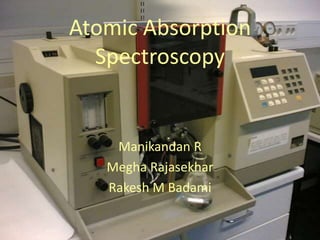
Atomic Absorption Spectroscopy (AAS)
- 1. Atomic Absorption Spectroscopy Manikandan R Megha Rajasekhar Rakesh M Badami
- 2. Introduction • Atomic absorption spectroscopy is quantitative method of analysis of metals and some non-metals • The technique was introduced in 1955 by Sir Alan Walsh in Australia • Concentrations are found in g/mL range (ppm and ppb)
- 3. Principle • In gaseous state atoms absorb ultraviolet or visible light and make transitions to higher electronic energy levels. • The wavelength of each transition is specific to each element – qualitative analysis • Beer-Lambert’s law can be applied to find concentrations using a calibration graph prepared from standards • Absorbance is directly proportional to path length and concentration
- 4. Selection criteria for Sample preparation The selection of a preparation method is dependent upon: • The analyte •The analyte concentration level •The sample matrix •The required sample size •The environmental considerations.
- 5. Sample Preparation • Dilution – sample is diluted in distilled water, acids or organic solvent • Decomposition – isolation of required element from the sample by heating with/without a reagent – Wet/acid decomposition (300C) – Dry ashing (400-500C )- destroying the combustible portion of the sample. Oxidising agents may be used – Microwave decomposition (100-200C ) – sample decomposed at high pressures in a Teflon container • Calibration curve must be prepared using different concentrations of the sample
- 6. Working • The atoms of the solid are converted to gaseous state in the atomiser • Radiation of specific wavelength is emitted by the hollow cathode lamp onto the gaseous atoms in the atomiser • The monochromator focuses the specific wavelengths onto the detector • The detector finds the amount of light absorbed • The concentration of atoms in the sample is directly proportional to the absorbance
- 7. Working
- 9. Hollow Cathode Lamp • Cathode is in the form of a hollow cylinder made of the metal which has to be analysed • Anode is made of tungsten filament • They are sealed in a tube filled with inert gas like Neon or Argon • A large voltage across anode and cathode causes the inert gas to ionize and form a plasma • These ions are accelerated towards the cathode causing atoms to be sputtered off
- 10. Hollow Cathode Lamp • The ions and metal atoms are excited due to collisions • They give off photons of a certain wavelength when they reach ground state
- 11. Nebuliser • The nebuliser forms a mist or aerosol of the sample • This is done by forcing the sample at high velocities through a narrow tube • The sample is mixed with a fuel and oxidant • Commonly used fuel-oxidant mixtures are acetylene-air and acetylene-nitrous oxide.
- 12. Nebuliser
- 13. Atomiser • In the atomiser the sample solutions is vaporised and the molecules are atomised • Atomiser can be of two types – Flame atomiser – Laminar consumption or total flow – Electro-thermal atomiser or graphite furnace
- 14. Atomiser • Flame atomiser – The flame is usually in the form of a sheet to increase path length and hence increase the absorbance and sensitivity. sample mist Solid/gas aerosol Gaseous molecules Atom
- 15. Atomiser • Flame atomiser – Laminar flow – a mixture of sample, fuel and oxidant is continuously introduced to the burner head – Total consumption – sample and fuel-oxidant mixture are delivered separately to the burner head. This is a much safer method and can be easily constructed.
- 17. Atomiser • Electro-thermal atomiser – Graphite rods heated by passing current – Sample goes through three phases to get vaporised – Drying - the solvent is evaporated – Pyrolysis – Sample temperature is then increased rapidly to vaporise it – Light is then passed through the sample
- 18. Interferences • Chemical interference – Presence of thermally stable compound that is not totally decomposed by the energy of the flame – High flame temperature provides energy for breakdown on interference – Addition of releasing agent which reacts with the interference
- 19. Interferences • Ionization interferences – Atoms of the samples are ionized causing reduction in number of electrons and absorbance – Addition of excess element, like alkali elements, which gets ionized easily – Flame temperature may be reduced
- 20. Interferences • Matrix interference – Due to viscosity, burning characteristics, surface tension of solvent – Due to usage of different solvents in calibration and sample – Addition of diluents to reduce viscosity • Background absorption – Light scattering by particles in flame or absorption by undissociated molecules – This must be measured and subtracted from final results – Absorption of elements occurs as a narrow line whereas interference occurs over a broad range
- 21. Applications • Level of metals could be detected in tissue samples like Aluminum in blood and Copper in brain tissues • Presence of metals as an impurity or in alloys could be found easily • Determination of elements in the agricultural and food products • Determination of lead in petrol • Determination of calcium and magnesium in cement
- 23. Advantages and Disadvantages • Advantages – High sensitivity – Easy to use – Inexpensive • Disadvantages – Different cathode lamp for different elements – Can detect only metals and some non metals – Only one element detected
- 24. References • Analytical Methods for Atomic Absorption Spectroscopy – Perkin-Elmer • Sample Preparation For Flame Atomic Absorption Spectroscopy: An Overview - Nabil Ramadan Bader • Atomic absorption spectrometry – Royal Society of Chemistry • NMSU web notes
Editor's Notes
- Oxidising to speed up, prevent volatilising of analyte
- Disadvantages – sample is lost, hence sample size is big
- Advantages – sample size is small, no preparation is required Disadvantages – may not be completely atomised, lesser precision
- Speak about monochromator and detector, chopper and ac currents
- Reducing flame temperature may cause chemical interference